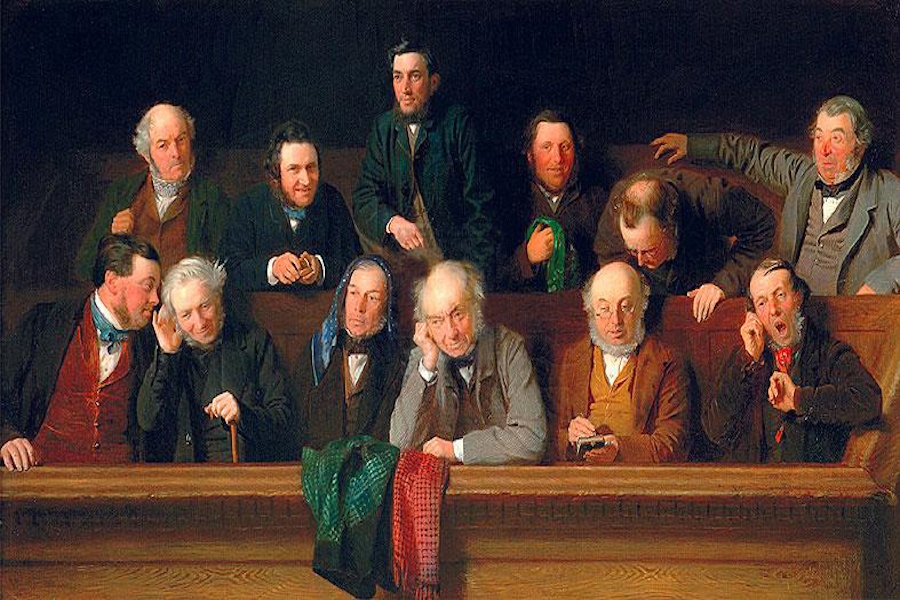Pressure mounts to change an antiquated Oregon jury rule.
In 1934 eleven jurors in Portland sought to convict a Jewish immigrant named Jacob Silverman of murder. They suspected him of aiding and abetting the fatal shooting of a Protestant white man. Silverman wound up with three years in prison and a $1,000 fine because a single juror held out for manslaughter.
Swept up in anti-immigrant fervor, voters wanted to make sure that didn’t happen again. Less than a month after the trial, they passed a ballot measure allowing non-unanimous jury verdicts.
The ruling stuck. Eighty years later, Oregon is one of only two states, along with Louisiana, where juries can convict defendants on a 10-2 vote in non-murder trials.
The American Civil Liberties Union of Oregon and the Oregon Criminal Defense Lawyers’ Association have long eyed a change. After a failed ballot measure in January, they’re switching tactics, pressuring legislators to amend the law in the 2019 session.
A number of Oregon lawmakers have publicly expressed interest, says Mary Sofia, a lobbyist for the Criminal Defense Lawyers’ Association. “They recognize the racist past,” she says, “and they know that it needs to be fixed.”
The unusual non-unanimous rule compounds a lack of minority representation in juries. Imagine a trial in which the defendant is black, a dissenting juror is black and the remaining jurors are all white.
“Walking into court is incredibly scary,” Sofia says, “I imagine it’s scarier for a defendant who doesn’t see themselves in a jury of their peers.”
“Walking into court is incredibly scary,” Sofia says, “I imagine it’s scarier for a defendant who doesn’t see themselves in a jury of their peers.”
That’s not a far-fetched scenario in Multnomah County. With a 79.5% white population, according to the 2017 census, a representative 12-person jury averages 2.4 minority jurors.
Most juries, however, are far from representative, according to national scholarship.
An article published by the American Bar Association argues that people of color, who are more likely to be of lower socioeconomic status, face barriers to serving on a jury. They move more frequently, making it difficult to deliver summons. They often hold part-time or hourly jobs, and can’t afford to trade a workday for token juror compensation (In Multnomah County, it’s $10 a day for the first two days, $25 thereafter).
If one or two minority jurors leap those hurdles, they face a final barrier to voicing their opinion: being overruled in a non-unanimous verdict.
“Imagine if you even had two minority jurors, which we don’t,” says Aliza Kaplan, a professor at Lewis & Clark Law School and the state’s leading expert on non-unanimous juries. “They can virtually be ignored in the jury room.”
Kaplan leads a small, but spirited, campaign against non-unanimous juries. Last Fall, she and her students wrote an amicus brief for Dale Lambert v. Louisiana, a Supreme Court Case challenging non-unanimity.
Her brief, while unsuccessful, refocused attention on the issue back home. In January, an unlikely advocate, the Oregon District Attorneys’ Association, announced support for a ballot measure to repeal the non-unanimous system. Speculation swirled over why prosecutors took aim at a rule that makes convictions easier.
The answer came when the district attorneys asked for a quid pro quo. They wanted to remove a second policy put in place by the 1934 ballot measure, the right of defendants to request a bench trial before a judge in place of a jury trial. Advocates like Kaplan refused to back a measure that included both changes.
“I also think it can be helpful,” Shirtcliff says, “If you have that rogue juror who isn’t going to actively participate, it helps prevent mistrials.”
Multnomah County District Attorney Rod Underhill sponsored the ballot measure, but his office declined to be interviewed for this article. Tim Colahan, executive director of ODAA in January, could not be reached after repeated phone calls.
Matt Shirtcliff, Baker County’s District Attorney and current president of ODAA, said the association hasn’t decided its position on non-unanimous juries, but will do so in the next month.
As a prosecutor, Shirtcliff remains undecided on the issue until he sees more data. “I also think [non-unanimous juries] can be helpful,” he says, “If you have that rogue juror who isn’t going to actively participate, it helps prevent mistrials.” He emphasizes that he is speaking for himself, not the ODAA.
Sofia and the ACLU think the legislature is the most promising avenue for change, but Shirtcliff says a ballot measure would be better. “It would need to go to voters,” he says. “It’s something the public needs to weigh in on.”
Kaplan says, “letting Louisiana outdo us on criminal justice is not a good look for Oregon.”
Time is ticking before Oregon becomes the last state standing. While Oregon lawyers deliberate, a Louisiana referendum is attracting bipartisan support for the November ballot. “Letting Louisiana outdo us on criminal justice is not a good look for Oregon,” Kaplan says.
This article has been edited to reflect the following correction: Matt Shirtcliff, not Tim Colahan, is the current president of the Oregon District Attorney’s Association.
To subscribe to Oregon Business, click here.





